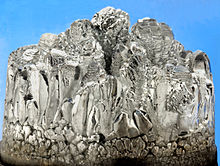DOUBLE BUBBLE MAPS
Define : Double Bubble Map is a great way to organize your thoughts when you are comparing and contrasting two things. In the middle you put how the two objects are alike. On the sides you put how the objects are different. We can compare and contrast a Books, People, Objects, Animals, Places,Music, Events, etc.
Magnesium (Mg)
Magnesium is a chemical element with symbol Mg and atomic number 12. It is a shiny gray solid which bears a close physical resemblance to the other five elements in the second column (Group 2, or alkaline earth metals) of the periodic table: all Group 2 elements have the same electron configuration in the outer electron shell and a similar crystal structure.
Sulfur (S)
Definition of SulfurWhat is the definition of Sulfur? In a general overview of the element we can at first describe Sulfur as a solid. It is a pale yellow non-metallic, brittle element and is widely distributed in close proximity to hot springs and volcanoes and is also found in many minerals and ores. The Physical and Chemical Properties are the characteristics of a substance, like Sulfur, which distinguishes it from any other substance. Most common substances exist as States of Matter as solids, liquids, gases and plasma. Refer to the article on Sulfurfor additional information and facts about this substance.
Sulfur Properties - What are the Physical Properties of Sulfur? What are the Physical Properties of Sulfur? The Physical properties of Sulfur are the characteristics that can be observed without changing the substance into another substance.
Physical properties are usually those that can be observed using our senses such as color, luster, freezing point, boiling point, melting point, density, hardness and odor. The Physical Properties of Sulfur are as follows:
- Color : Pale yellow - Non-metallic
- Phase : Solid
- Crystalline structure & Forms : Rhombic, Amorphous and Prismatic
- *Allotropic : There are several known allotropes including brimstone
- Odor : Odorless
- Taste : Tasteless
- Solubility : Insoluble in water


What is the fundamental difference between the two elements?
BalasHapusYou can see in my write.
HapusPeriod, colour etc.
Can you give me the chemical properties of magnesium and sulfur?
BalasHapusMagnesium :
HapusMagnesium is very chemically active, it takes the place of hydrogen in boiling water and a great number of metals can be produced by thermic reduction of its salts and oxidized forms with magnesium.
Sulfur :
Lenntech
Toggle navigation
Home Periodic table Elements Sulfur
Sulphur - S
Chemical properties of sulphur - Health effects of sulphur - Environmental effects of sulphur
Atomic number
16
Atomic mass
32.06 g.mol -1
Electronegativity according to Pauling
2.5
Density
2.07 g.cm -3 at 20 °C
Melting point
113 °C
Boiling point
445 °C
Vanderwaals radius
0.127 nm
Ionic radius
0.184 (-2) nm ; 0.029 (+6)
Isotopes
5
Electronic shell
[Ne] 3s23p4
Energy of first ionisation
999.3 kJ.mol -1
Energy of second ionisation 2252 kJ.mol -1
Energy of tird ionisation 3357 kJ.mol-1
Standard potential
- 0.51 V
Discovered by
The ancients
Sulphur - S
Sulphur
Sulphur is a multivalent non-metal, abundant, tasteless and and odorless. In its native form sulphur is a yellow crystalline solid. In nature it occurs as the pure element or as sulfide and sulfate minerals. Although sulphur is infamous for its smell, frequently compare to rotten eggs, that odor is actually characteristic of hydrogen sulphide (H2S).
The crystallography of sulphur is complex. Depending on the specific conditions, sulphur allotropes form several distinct crystal structures.
Applications
The major derivative of sulphur is sulphuric acid (H2SO4), one of the most important elements used as an industrial raw material.
Sulphur is also used in batteries, detergents, fungicides, manufacture of fertilizers, gun power, matches and fireworks. Other applications are making corrosion-resistant concrete which has great strength and is forst resistant, for solvents and in a host of other products of the chemical and pharmaceutical industries.
Sulphur in the environment
Life on Earth may have been possible because of sulphur. Conditions in the early seas were such that simple chemical reactions could have generate the range of amino acids that are the building blocks of life.
Sulphur occurs naturally near volcanoes. Native sulphur occurs naturally as massive deposits in Texas and Louisiana in the USA. Many sulphide minerals are known: pyrite and marcaiste are iron sulphide ; stibnite is antimony sulphide; galena is lead sulphide; cinnabar is mercury sulphide and sphalerite is zinc sulphide. Other, more important, sulphide ores are chalcopyrite, bornite, penlandite, millerite and molybdenite.
The chief source of sulphur for industry is the hydrogen sulphide of natural gas, Canada is the main producer.
Health effects of
I hope you understand😁
Komentar ini telah dihapus oleh pengarang.
HapusMagnesium can react with any element? Please explain
BalasHapusBecause mg have chemical properti is :
HapusMagnesium is very chemically active, it takes the place of hydrogen in boiling water and a great number of metals can be produced by thermic reduction of its salts and oxidized forms with magnesium.